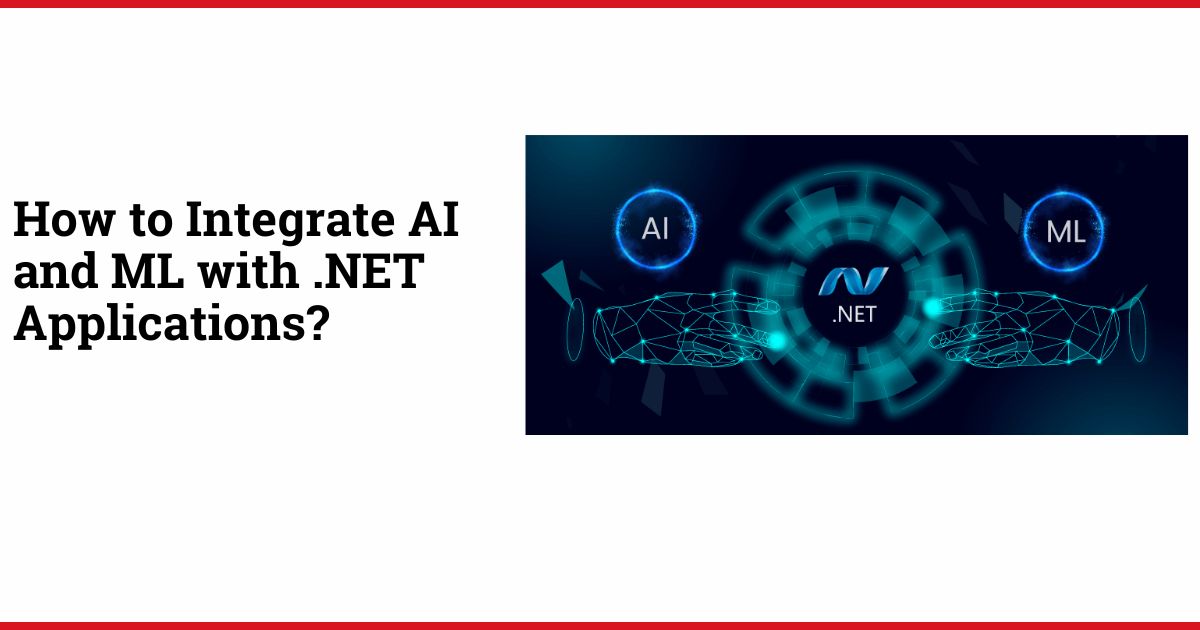
Enterprises encounter considerable hurdles in the business environment, impeding productivity and growth. Organizations are frequently under pressure to do anything from composing enormous volumes of data to delivering individualized customer experiences. Thus, integrating machine learning (ML) and artificial intelligence (AI) into apps can potentially transform how businesses operate. For more than two decades,.NET applications have had a strong reputation in the commercial sector. This is owing to their exceptional features like speed, security, scalability, and stability. Organizations understand the value of AI-powered.NET applications and employ ML Models in.NET Apps to address changing dynamics and close operational gaps.
Businesses continuously seek methods to improve decision-making, facilitate operations, and stay ahead of the competition. The immaculate answer is to partner with a reliable .NET services provider who can impeccably integrate AI and ML capabilities into a .NET application. This strategic move can help enterprises overpower data overload and process automation challenges, leading to more knowledgeable conclusions and efficient operations.
This guide on .NET AI development will provide you with the necessary information to embark on this digital transformation journey and reassure you of the potential benefits of cognitive computing in a .NET applications development company.
Why is it necessary to migrate to an AI/ML-enabled.NET Enterprise Infrastructure?
The need to shift to an AI/ML-enabled.NET corporate infrastructure stems from several long-standing business concerns. These involve managing vast amounts of data, making informed judgments, maintaining operational efficiency, and conquering intensely competitive markets. AI/ML, together with.NET, offers innovative software solutions to address these difficulties. AI/ML provides an edge by allowing for customized client experiences. Data-driven decision-making is boosted by AI/ML’s capacity to sift through enormous datasets and develop pertinent insights. It lowers costs and errors by automating repetitive tasks, improving functional efficiency, and forecasting trends.
What are the benefits of using AI and machine learning in.NET applications?
When Artificial Intelligence (AI) and Machine Learning (ML) are integrated into .NET applications, with the help of ML development services providers, software capabilities reach previously unimaginable heights.
Enhanced Precision and Efficiency
Using AI and ML increases the accuracy and productivity of .NET applications. Sophisticated algorithms can complete jobs more precisely over time because they continually learn and change.
Improved User Experience
AI and machine learning enable an easy and tailored user experience. By evaluating user behaviour, preferences, and patterns, these technologies allow .NET applications to modify interactions, resulting in a more engaging and user-friendly interface.
Predicting Maintenance
Integrating AI and machine learning with .NET enables predictive maintenance capabilities. Applications can foreshadow shortcomings and inefficiencies, authorizing preemptive steps, decreasing downtime, and enhancing overall system performance.
Scam Detection
AI and machine learning are exceptionally good at catching patterns and anomalies. These technologies are beneficial in detecting fraud in.NET applications since they immediately discover anomalies and enhance security mechanisms to prevent fraudulent behaviour.
Advanced Analytics
Integrating AI and machine learning into .NET applications with the help of a .NET applications development company enables advanced analytics. These tools examine large-scale databases, furnishing insightful analysis and allowing firms to create data-driven decisions that raise general productivity and competitiveness.
Chatbots
Chatbots and AI-powered virtual assistants may be readily connected with .NET apps, providing users with dynamic and interactive user interfaces. These intelligent agents improve communication, reply to requests, and facilitate user interactions to provide a more engaging user experience.
Hire .NET developers to ensure optimal integration performance. In conclusion, employing AI and ML in .NET apps is a deliberate move toward innovation rather than a passing trend. Combining these technologies offers a world of possibilities for your applications, ushering them into a new era of intelligent and adaptable computing. These possibilities include increased accuracy and efficiency, predictive maintenance, and enhanced analytics capabilities.
How Do You Integrate Algorithms and Machine Learning into .NET Applications?
Are you starting to integrate machine learning (ML) and artificial intelligence (AI) into your .NET application? For a smooth integration operation, follow these steps used by ML development services providers:
Identify a Use Case Example
Clearly define the problem you wish to solve with machine learning and artificial intelligence. Choose a real-world circumstance that corresponds to the goals of your application.
Gather and Organize the Data
Compile the necessary information for your use case. Ensure it’s clean, orderly, and adequate for training your model. High-quality data is the foundation of every successful AI and machine learning integration
Ensure you Use the Appropriate Tool or Library
Choose the AI and machine learning libraries or technologies most suited to your project. TensorFlow, PyTorch, and ML.NET are popular options for easy interaction with .NET applications.
Model Training
Use the collected data to train your machine-learning model. Adjust setups and parameters to increase accuracy. This is a critical step toward developing a dependable and functional model.
Analyze the Layout
Recognize how your .NET application’s design will support your AI/ML models with the help of a .NET applications development company. Ensure compatibility and identify integration points for the best outcomes.
Conclusion
Introducing AI and ML into .NET applications opens up possibilities for efficiency and creativity. This comprehensive reference examines the subtleties of merging this innovative technology and offers guidance on developing intelligent applications. As businesses increasingly rely on AI and machine learning, it is vital to understand how they integrate within the .NET ecosystem.
With this guidance, ML development services providers can begin designing clever, sophisticated apps that meet and exceed expectations, ensuring a competitive and future-ready software environment.
Author Bio
Mosche Amara, a seasoned tech writer, explores AI’s and ML’s transformative potential across industries, offering insights for businesses to innovate and thrive in dynamic landscapes.








